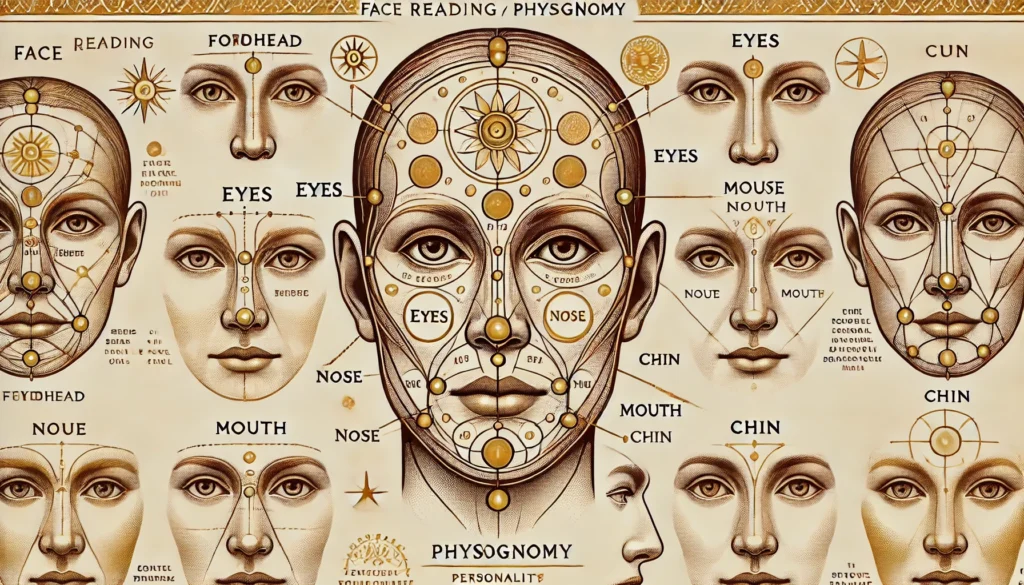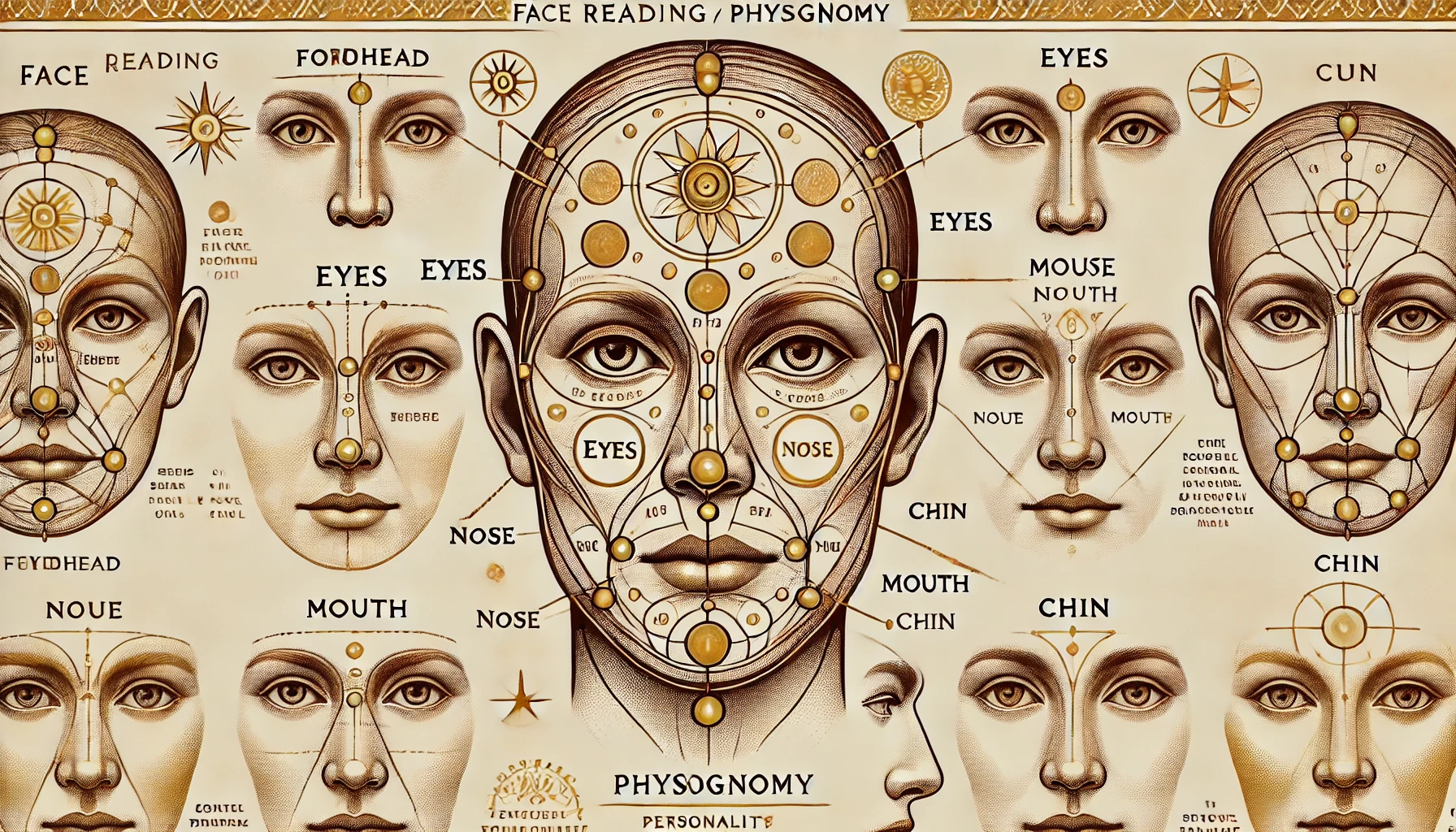Date
Face reading, also known as physiognomy, is an ancient practice that interprets facial features to reveal personality traits, emotions, and even a person’s destiny. This art has been used for centuries in various cultures, including Chinese Mian Xiang and Indian Samudrik Shastra. In this blog, we will explore how different facial features can provide insights into an individual’s character and life.
1. Introduction to Face Reading
Face reading is based on the idea that our facial features reflect our inner nature and experiences. It is used in personality assessment, career guidance, relationship compatibility, and even medical diagnosis. Each facial feature, from the forehead to the chin, has a unique meaning and can offer valuable insights.
History of Face Reading
Ancient Chinese scholars developed Mian Xiang, a system of facial analysis, to predict fortunes and health.
Greek philosophers like Aristotle and Hippocrates believed facial characteristics could indicate personality traits.
In India, Samudrik Shastra describes the significance of facial features in understanding a person’s destiny.
2. The Five Key Facial Areas in Face Reading
Face reading generally focuses on five key areas:
Forehead – Represents intelligence, career, and mental abilities.
Eyebrows – Reflect emotions, confidence, and social interactions.
Eyes – The windows to the soul, indicating personality, honesty, and emotions.
Nose – Symbolizes financial status, decision-making, and self-esteem.
Lips and Mouth – Indicate communication skills, relationships, and emotional expression.
Let’s dive deeper into each feature and its meaning.
3. What Your Forehead Says About You
The forehead represents intelligence, wisdom, and career prospects.
Broad forehead: Intelligent, quick learner, strong leadership skills.
Narrow forehead: Thoughtful, deep thinker, creative but may lack practicality.
Rounded forehead: Emotional, sensitive, artistic.
Flat forehead: Logical, practical, and methodical.
High forehead: Intellectual and strategic thinker.
Wrinkles on forehead: Indicate stress, wisdom, or a challenging life journey.
4. Eyebrows and Their Significance
Eyebrows reveal a lot about a person’s confidence and social skills.
Thick eyebrows: Strong-willed, determined, and independent.
Thin eyebrows: Sensitive, cautious, and sometimes indecisive.
Arched eyebrows: Creative, expressive, and good at public relations.
Straight eyebrows: Logical, straightforward, and honest.
Unibrow: Highly focused, intense thinker, but can be obsessive.
5. Eyes: The Window to the Soul
Eyes provide deep insights into a person’s emotions and sincerity.
Large eyes: Expressive, open-minded, and emotional.
Small eyes: Observant, detail-oriented, and analytical.
Almond-shaped eyes: Balanced, calm, and emotionally stable.
Deep-set eyes: Introspective, intuitive, and mysterious.
Protruding eyes: Outgoing, talkative, and sociable.
Dark circles or bags under eyes: Stress, health concerns, or emotional baggage.
6. Nose Shape and Personality
The nose plays a vital role in face reading, reflecting financial and leadership abilities.
Straight nose: Disciplined, hardworking, and honest.
Rounded nose: Generous, kind-hearted, and creative.
Pointed nose: Sharp-minded, detail-oriented, and perfectionist.
Wide nose: Strong-willed, independent, and practical.
Short nose: Friendly, flexible, and adaptable.
Crooked nose: Unique, unconventional thinker, risk-taker.
7. Lips and Mouth: Communication and Relationships
Lips reveal how a person communicates and expresses emotions.
Full lips: Generous, expressive, and romantic.
Thin lips: Practical, reserved, and disciplined.
Wide mouth: Outgoing, talkative, and confident.
Small mouth: Introverted, cautious, and selective in relationships.
Upturned lips: Positive, optimistic, and cheerful.
Downturned lips: Serious, analytical, and sometimes pessimistic.
8. Chin and Jawline: Strength and Determination
Strong jawline: Determined, ambitious, and a natural leader.
Weak jawline: Sensitive, adaptable, and peace-loving.
Pointed chin: Sharp-minded, witty, and energetic.
Square chin: Practical, assertive, and dominant.
Rounded chin: Kind-hearted, diplomatic, and easygoing.
9. Face Shapes and Their Meanings
Round face: Friendly, sociable, and caring.
Oval face: Intelligent, balanced, and diplomatic.
Square face: Strong-willed, ambitious, and disciplined.
Heart-shaped face: Creative, intuitive, and passionate.
Diamond-shaped face: Confident, determined, and perfectionist.
10. Common Myths About Face Reading
Face reading is often misunderstood. Some myths include:
“Face reading is just superstition” – While it may not be scientifically proven, many ancient practices support its accuracy.
“It predicts the exact future” – Face reading provides tendencies, not absolute outcomes.
“Facial features never change” – Life experiences and emotions can subtly alter facial features over time.
11. Practical Applications of Face Reading
Career Guidance: Helps in understanding strengths and weaknesses for better career choices.
Relationship Compatibility: Can provide insights into a person’s emotional nature.
Health Indicators: Some facial features may indicate underlying health conditions.
Business and Social Interactions: Used in negotiations and hiring processes.
12. How to Improve Your Face Reading Skills
Observe people carefully and take note of their expressions and features.
Read books and articles on face reading.
Compare face reading insights with real-life experiences.
Practice analyzing your own face in a mirror.
Keep an open mind and avoid making judgments based solely on appearance.
Conclusion
Face reading is a fascinating art that can help decode a person’s inner world through facial features. While it should not be taken as an absolute science, it can offer valuable insights into personalities, emotions, and even life paths. Whether you use it for personal growth, social interactions, or curiosity, face reading can be a powerful tool to understand people better.
Do you want to learn more about specific facial features or need a personalized face reading guide? Let us know in the comments!




